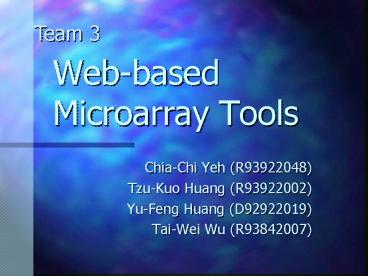Webbased Microarray Tools - PowerPoint PPT Presentation
1 / 21
Title:
Webbased Microarray Tools
Description:
Web-based Microarray Tools. Chia-Chi Yeh (R93922048) Tzu-Kuo Huang (R93922002) ... Every analysis tool has its own user interface - a long learning phase. ... – PowerPoint PPT presentation
Number of Views:20
Avg rating:3.0/5.0
Title: Webbased Microarray Tools
1
Web-based Microarray Tools
Team 3
- Chia-Chi Yeh (R93922048)
- Tzu-Kuo Huang (R93922002)
- Yu-Feng Huang (D92922019)
- Tai-Wei Wu (R93842007)
2
Outline
- Motivation
- Features
- System Overview
- Built-in Functions
- Data Flow
- Demonstration
3
Motivation
- Every analysis tool has its own user interface -gt
a long learning phase. - Each tool only provides few functionalities -gt
transfer from one tool to another frequently. - Some tools are commercial -gt no way to customize
them to fit ones needs.
4
Features
- Friendly user interface We provide a uniform
interface for every function. - Flexibility It is easy to import modules in our
system. - Transparency All the details of underlying
packages are transparent to the end-users. - Open source Everything we used is publicly
available on the internet.
5
System Overview
intensity
intro
modules
dataset
plot
function
t-test
process
submit
browser
pca
status
wrapper
CEL file
hcluster
result
6
Built-in Functions
- Plot a probe intensity image for an Affymetrix
CEL file. intensity - Compare gene expression levels between two
samples. plot - Determine genes that have significantly different
expression levels in two types of samples.
t-test - Use PCA(Principle Component Analysis) to perform
clustering. pca - Hierarchical Clustering. hcluster
7
Data Flow (1/2)
- From users view
- Read introduction of this website. intro
- Choose a function to perform. function
- Upload files and submit the job. submit
- Watch job status and wait. status
- During waiting, a user may choose another
function and submit jobs. - Get the result when a job is done. result
8
Data Flow (2/2)
- From systems view
- Show available functions. function
- For a chosen function, render the input fields
and submit form. submit - Check function, options, and uploaded files of a
submitted job. process - If no error, execute the corresponding module at
the background. wrapper - Monitor all the submitted jobs. status
- Show the result when a job is done. result
9
Demonstration
- Now we are going to demonstrate how to use our
system to complete homework 5. - We use the HCC1648 dataset, and the input files
are available on our website. - Please read this guide carefully and make sure
the input files are correct, or you will waste
everyones time.
10
Step 1 Prepare Files (1/3)
- The input file is compatible with the
TAB-delimited text file in Microsoft Excel. - The first row contains sample names, the first
column contains gene names, and other cells are
real numbers. - Our system will simply replace missing values by
zero. If you want to handle them in a different
way, please impute them manually before uploading.
11
Step 1 Prepare Files (2/3)
- Download HCC1648 dataset.
- Open it with Excel.
- Remove useless rows and columns.
- Edit the gene names if you want.
- Put normal samples (Liver) in one sheet, and
tumor samples (HCC) in another. - Save them as TAB-delimited text file.
12
Step 1 Prepare Files (3/3)
Sample names
Impute the missing value or system will fill it
by zero.
Save as TAB-delimited text file
Gene names
13
Step 2 Select a Function (1/2)
Click!
14
Step 2 Select a Function (2/2)
For example, click t-test.
15
Step 3 Upload Files
16
Step 4 Submit a Job
Click!
17
Step 5 Get Results (1/3)
Wait until it is done.
18
Step 5 Get Results (2/3)
Step 5 Get Results (2/3)
Click to view the results.
19
Step 5 Get Results (3/3)
Step 5 Get Results (3/3)
20
Useful Information
- You can submit many jobs at the same time, and
the status page shows every job you submitted in
this session. - The results of each function are described in the
result page. - If you close your browser, your session and
submitted jobs are lost.
21
About Homework 5
- First run t-test and get the results.
- Then delete entries in your input files which are
not in gene.txt. - Run one of the clustering functions using the
cleaned input files. - If no errors, the results are what you want.
- If you have problem with hcluster, just use pca
or kmeans instead.































